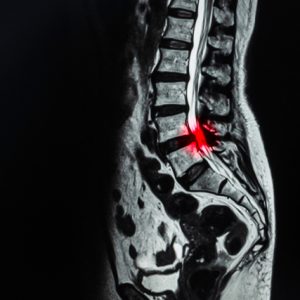What Is Spinal Stenosis?

By Peter Porrini at Shutterstock
Stenosis is the abnormal narrowing of a channel within the body. Spinal stenosis is a narrowing of the bone channel that houses the spinal nerves or the spinal cord. There are many people born each year with a congenital form, but many develop spinal stenosis due to degenerative diseases. Some don’t even feel the negative effects of the narrowing process.
Eventually, due to aging, most will feel a radiating pain, weakness, or numbness in the nerves and spinal cord. A specialist can perform a series of tests to determine the cause of the narrowing and its exact location.
Lumbar vs. Cervical Stenosis
Spinal stenosis can be further broken down into two primary types: lumbar stenosis and cervical stenosis. The lower back will develop lumbar stenosis while the neck will develop cervical stenosis.
Lumbar Spinal Stenosis
In this condition, the spinal nerve roots of the lower back compress and develop the symptoms of sciatica – a tingling, weakness, or numbness radiating from the lower back down into the legs. The symptoms of lumbar spinal stenosis often mimic those of vascular insufficiency. Both lead to claudication (leg pain while walking).
Symptoms of lumbar spinal stenosis include:
- Numbness
- Tingling in the hands, arms, feet, or legs
- Weakness in the hands, arms, feet, or legs
- Neck pain
- Difficulty walking or balancing
- Bowel or bladder dysfunction.
Cervical Spinal Stenosis
Cervical spinal stenosis in the neck is a condition in which the patient experiences a compression of the spinal cord. In most cases, spinal cord compression leads to extreme weakness and lifelong paralysis. Anyone who developers signs of spinal cord compressive may require invasive treatment, including surgical operations, to ease the discomfort and pain.
Symptoms of cervical spinal stenosis include:
- Numbness or tingling in the feet or legs
- Weakness in the feet or legs
- Pain or cramping in one or both legs while standing
- Back pain
Spinal Stenosis and Age
Most commonly, spinal stenosis begins to develop around the age of 50 or older. The degeneration of the spine becomes increasingly noticeable. Because the process is gradual and rarely leads to severe symptoms immediately, the changes caused by spinal stenosis are often minor at first. You might notice a decrease in your physical abilities or develop a forward-flexed posture while sitting.
If you examine pictures of yourself from before and after you develop spinal stenosis, you’ll certainly note the differences. However, while going about your daily life, you’ll likely overlook these signs.
Experiencing the onset of spinal stenosis symptoms? Please visit our center today for your first consultation. You can schedule an appointment with Bay Area Disc Centers by calling 408-866-0300!
